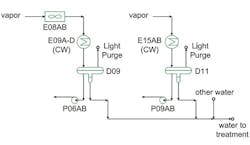Correctly Contend with Control Valve Leakage
A wastewater plant needed to reduce its emissions of volatile organic compounds. Troubleshooting identified excess light hydrocarbons in the water as the culprit. The water came from a common wastewater collection header shared by two distillation columns. Samples from different points on the header isolated the possible problem source as being the overhead system of one of two towers. Both had the same configuration (Figure 1).
Figure 1. Both towers have water as a minor contaminant and a low water purge rate.
Water purge rates from both towers were very low. In each system, water was a minor contaminant in the feed, appearing at a concentration that varied from 1,000 wppm to 5,000 wppm. More than 90% of the time, the level control valves on the water were closed. The drum-water-boot level measurement often was 0% of range. Downstream flow control valves in the water lines showed flows that were very low and were interpreted as no flow. After all, if the level control valves were closed the flow rate must be zero.
Water rates were checked by manually closing the isolation valves upstream and downstream of the level control valves and then monitoring the boot-water level instruments. Over time, the water level rose in both boots. The water accumulation rate was estimated based on how long the level instrument took to go from 25% to 75% of span. Once the water level reached 75% of span, the isolation valves gradually were opened and the water level was allowed to return to control.
The water level test showed that water continuously accumulated at a low rate. However, once returned to control, both instruments went back to zero level. Both control valves returned to a nominally fully closed position. Differential pressure across each control valve was ~125 psi. At the low end of the expected water in the feed, the level control valves leaked more than the total expected water rate. Excess leakage ended up as hydrocarbons entering the water treatment system.
The key point to realize is that control valves don’t seal 100% tight. The American National Standards Institute (ANSI) classifies control valves into six leak classes, I to VI. Table 1 summarizes the ANSI valve class requirements. Going up in class reduces the leak rate and increases the cost. Getting a tight seal costs a lot of money. Tight sealing mandates a soft seat on the valve, which also may limit valve operating conditions. The engineer must select a valve that meets process requirements. If the process demands close-to-zero leakage, then spend the money. However, if the process doesn’t need tight sealing, then save money by using a lower-sealing-class valve.
Table 1. Most plants opt for either Class IV or Class V valves for process streams.
Most plants choose either Class IV or Class V valves for process streams. Class I to Class III valves often handle bypasses and non-critical utility or water systems. Class VI valves typically are selected only when even very small leak rates are unacceptable. Class VI valves use soft seats against which the metal valve components tightly seal; the soft seat materials chosen must suit process compositions and conditions. Class V and Class VI valves also may require special actuators for tight sealing.
When dealing with low flow rates on level control, you may apply different strategies, including:
• specifying tight-sealing (Class VI) valves as needed;
• using the minimum-size control valve consistent with the flow rates required;
• controlling level manually on an intermittent basis (i.e., having operators periodically perform a manual level check and drain);
• cascading multiple drains into a single level control to provide a higher rate for the final level control; or
• combining multiple drains into a single level control to minimize pressure drop across the final level control.
The solution used in this case went to the smallest control valve. The original control valve had been sized based on water draining during a water wash at startup. A smaller control valve kept the water level in the control range at all times. Procedures were changed to use a much larger manual drain for the startup wash.
Remember that control valves leak. This may cause problems in both normal operations and during abnormal events. Appropriately using Class VI valves can minimize leakage — but at a cost.



